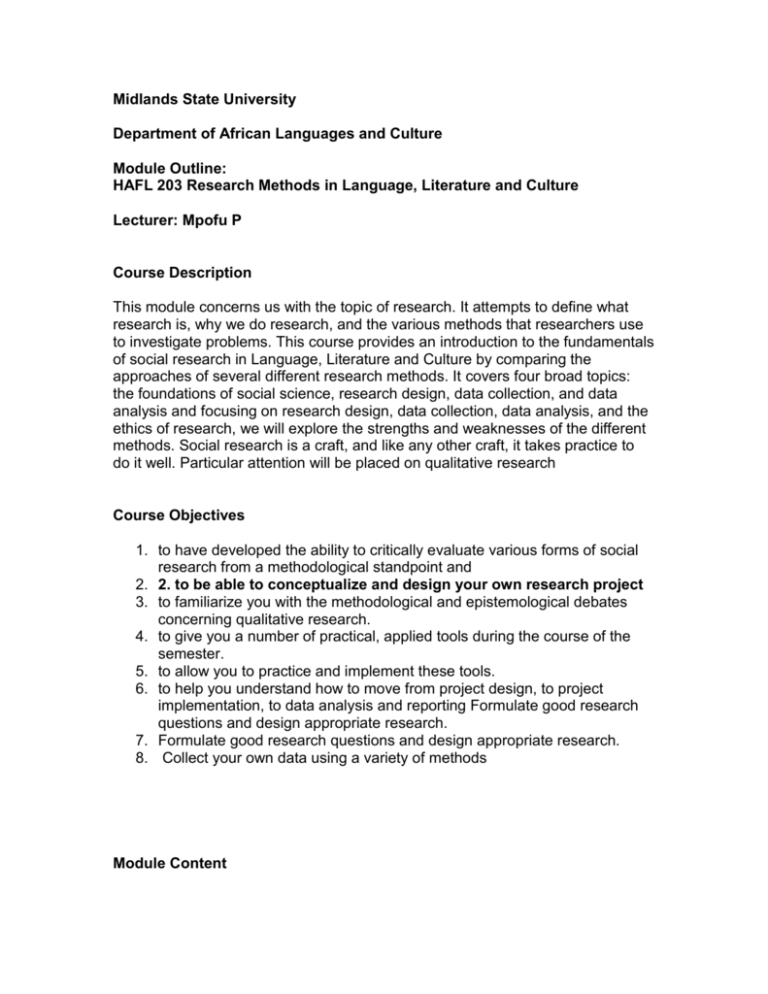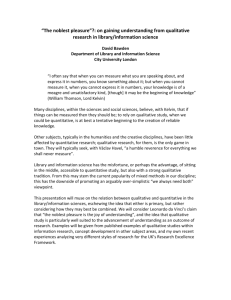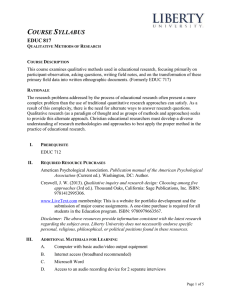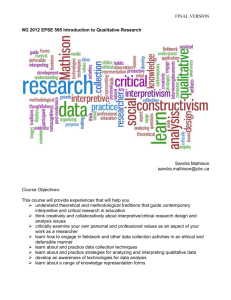Course Requirements & Grading
advertisement

Midlands State University Department of African Languages and Culture Module Outline: HAFL 203 Research Methods in Language, Literature and Culture Lecturer: Mpofu P Course Description This module concerns us with the topic of research. It attempts to define what research is, why we do research, and the various methods that researchers use to investigate problems. This course provides an introduction to the fundamentals of social research in Language, Literature and Culture by comparing the approaches of several different research methods. It covers four broad topics: the foundations of social science, research design, data collection, and data analysis and focusing on research design, data collection, data analysis, and the ethics of research, we will explore the strengths and weaknesses of the different methods. Social research is a craft, and like any other craft, it takes practice to do it well. Particular attention will be placed on qualitative research Course Objectives 1. to have developed the ability to critically evaluate various forms of social research from a methodological standpoint and 2. 2. to be able to conceptualize and design your own research project 3. to familiarize you with the methodological and epistemological debates concerning qualitative research. 4. to give you a number of practical, applied tools during the course of the semester. 5. to allow you to practice and implement these tools. 6. to help you understand how to move from project design, to project implementation, to data analysis and reporting Formulate good research questions and design appropriate research. 7. Formulate good research questions and design appropriate research. 8. Collect your own data using a variety of methods Module Content Foundations of Social Science Research I. The nature and scope of social research- what is social research? ; Research history; the scientific approach; Research traditions; Types of research; Stages of the research process II. Formulation of the research problem- Selection of a general topic; Literature review and the exploratory study; Specification of objectives and hypotheses; Concepts and variables Research Designs III. Selection of research design- Basic elements of research design; Major types of design and their relative functions; Experimental design; Social survey; Ethnographical/Case study: its exploratory nature; Historical design; Evaluative research Data Collection IV. Data collection Instruments and techniques, questionnaire, interview, observation etc V. Sampling- Why Sampling; types VI. Research ethics VII. Measurement and the problem of causality-. Levels of measurement: nominal, ordinal, interval and ratio; Reliability and validity; Construction of composite scores: typology, index and scaling; Problems of making causal inference Data Analysis VIII Processing and presenting data- Qualitative and Quantitative analysis of data; detailed descriptions, frequency distribution, stem and leaf diagrams, graphs (histogram, polygon, ogive), charts (bar and pie), pictograms; Statistics- mean, mode, median, range, variance, standard deviation Publishing/Reporting of Findings IX . Writing a research report/ dissertation/ thesis- Research proposal (the research topic, background of study, objectives, research questions, significance of study, delimitations, limitations, definition of terms, literature review, theoretical framework, methodology, data presentation and analysis plan, chapter headings, timeline, budget; Conducting the research (fieldwork); Writing the research report – Preliminaries- title page, abstract, acknowledgements, dedication, table of contents, list of tables, list of figures; The text-Introductory chapter (chapter 1), chapters forming the study, concluding chapter; Referencing techniques (books, journals etc ), Appendices (questionnaires, letters, interviews etc) Course Requirements & Grading Coursework (30%) Assignments: There will be one individual assignment for the semester that requires you to implement and analyze various qualitative methods. Your analyses should be thoughtful, specific, and detailed. Always provide relevant examples when making arguments. Always be specific. These will be graded and returned to you one to two weeks after they are due. Seminar presentations: There shall be group presentations on given topics, which should show detailed coverage, sound analysis and argument, augmented by good presentation skills. Research Proposal: The course will culminate in a formal proposal, or plan, for future research. The proposal could be an early version of your dissertation or thesis proposal. It could also be a plan for an article, or series of articles you wish to do. The proposal should entail a discussion of your research question, the motivation and background for that question, a brief literature review, your defense of the research methodology, an overview of your project (the sections or chapters you will write and what they will include). We will discuss each proposal in class. Be prepared to give a brief ?defense? of your proposal (10-15 minutes) . Examination 75%: Consists of a three hour paper written at the end of the semester. What ethical obligations do qualitative researchers have? A NOTE ON WRITING AND PLAGIARISM I expect that the papers/reviews/projects you turn in to me reflect college level writing skills. What does this mean? 1) There will be no spelling errors. For those of you with access to computers with fancy word processing programs and spell checker programs, there is absolutely no excuse to misspell a word. For those of you who still rely on typewriters, you will have to resort to old-fashioned proofreading. Even those with computers should proofread your papers before turning them in or have a friend proofread them for you. 2) There will be few grammatical errors. Again, I know of at least two grammar checker programs out there for computers. If you don’t have access to a computer with such programs, I suggest The Little, Brown Handbook or the Chicago Manual of Style as grammar references. They are available at bookstores and in the library. 3) The papers/reviews/projects will be well-organized and cohesive. If you know your writing is not as good as it should be, please use one of the academic resource centers on campus. That is why they are there. As for plagiarism or other forms of cheating, they will simply not be tolerated. Familiarize yourself with the policy here at C.C.S.U. I would rather you hand in a paper/review/project with too many footnotes and references than one in which you do not cite your sources. Any person guilty of plagiarism will immediately receive an F for the paper/review/project and the matter will be brought to the attention of the Dean of Student Academic Affairs for further action. So please, don’t even think it... I have caught several students before. It was not a pleasant experience for me, and you can be sure it was not pleasant for the students. Plagiarism Plagiarism is not accepted. Included in the definition of plagiarism are: deliberately copying the work of another student; copying directly from any published work without using quotation marks; failing to acknowledge sources used in submitted assignments with proper citation methods; re-submitting an assignment used in one course as an original piece of work for another course 1. In the phrase “qualitative data analysis”, the adjective “qualitative” can be read as modifying either “data” or “analysis”. This suggests the possibility that both data and methods can be classified in terms of a qualitative vs quantitative dimension, as shown in the table below. Data Qualitative Quantitative Analyses Qualitative Quantitative Discuss each of the four cells of the table, giving examples of specific methodologies that fit in each one. In addition, discuss the usefulness and sharpness of the qual-quant distinction, and as well as the data-analysis distinction 2. Sampling errors and sample size 3. Selection of sample units: probability and non-probability VI. METHODS OF DATA COLLECTION 1. Interview and questionnaire 2. Observation 3. Documents and content analysis 4. Unobtrusive measures VII. ANALYSIS AND INTERPRETATION OF DATA 1. Editing, coding, and tabulation 2. Statistical analysis: Description and inference 3. The meanings and implications of results: why so and so what? VIII. CONCLUDING REMARKS 1. Formulating the research proposal 2. Writing the research report Grading: Exercise 30% Tutorial performance 20% Examina









